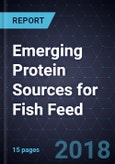This edition of Future Tech TOE covers emerging alternative protein sources for fish feed. The challenge facing the aquaculture industry is to identify economically viable and environmentally friendly alternatives to fish meal and fish oil on which many present aquafeeds are largely based.
With wild capture fisheries at their limit of exploitation under the current management regime, there is an increasing need to augment their use with alternative, non-marine ingredients. This Future Tech TOE captures innovations addressing the alternative fish protein needs, its impact on aquaculture efficiency and technology readiness level, market drivers and challenges, and also presents a patent analysis of the space.
The Future Tech TechVision Opportunity Engine (TOE) captures emerging innovations in research and development, or profiles existing technologies which have seen a resurgence in terms of new markets and applications. It usually provides a technology overview, drivers, challenges, research and development, analyst insights and key patent information.
In some cases, technology convergence scenarios and future growth opportunities are outlined. It covers innovations and technologies in a variety of industry spaces including manufacturing, sensors, electronics, information and communications technologies, networks, lighting technologies, healthcare, medical devices, materials and coatings, and developments in the energy sector that contribute toward a sustainable and greener world.
The Energy and Environment cluster provides global insights and intelligence on a wide variety of disruptive emerging technologies and platforms ranging from energy storage, advanced batteries, solar and wind energy, to unconventional oil, bioenergy, geothermal energy, and energy transmission.
Fish Feed Market - Global Industry Size, Share, Trends, Opportunity, and Forecast, 2019-2029F
- Report
- 180 Pages
- Global








